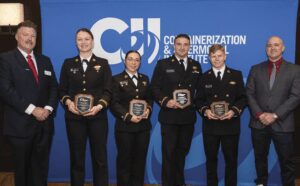By Patricia McCarthy, Professional Mariner.
Offering scholarships to students interested in maritime careers has become a major component of workforce development efforts by industry organizations, private companies and others trying to address the maritime workforce shortage.
The American Maritime Partnership (AMP) — a coalition that represents the U.S. domestic maritime industry, including shipping companies, mariners, shipyards, pro-defense organizations and others — lists nearly 40 available scholarships on its website.
These run the gamut, being offered by military academies, corporations, societies, organizations, magazines, transportation and other clubs, private trusts and more, with most geared toward general maritime students but some aimed at women, minorities, veterans and those pursuing very specific fields — from ocean engineering to advanced hydrodynamics and wave theory.
Without scholarships to mitigate costs, many would-be students would be shut out of higher education, and those pursuing maritime careers are no exception.
“Giving scholarships is the right thing for companies to do, and we really see it as a way to pay it forward as we help upcoming and emerging leaders in our industry,” said Jim Bender, manager of community partnerships and workforce strategy for Crowley, a logistics, marine and energy solutions company with divisions that include Crowley Shipping.

“In the big picture, we want these students to not only consider our industry but to consider Crowley as a future employer,” Bender said. “The maritime industry is in significant need of more mariners and shoreside workers, so it’s vital to our nation’s economy and to our nation’s defense to do everything we can to introduce these students to our industry and then walk them along the journey.”
Since 1984, Crowley has awarded over $3 million in scholarships to more than 1,000 students, mostly focused on helping cadets complete training at the seven maritime academies in the United States. The company also offers scholarships to students studying marine science, business, engineering and STEM at select institutions.
With the average annual cost of the six non-federal maritime academies ranging from $30,000 to $60,000, it’s quite expensive.
“So for us to be able to give them a little help to get through is very important for them to be able to finish their schooling,” Bender said.
Jennifer Carpenter, president of both the AMP and American Waterways Operators — the national trade association for the U.S. tugboat, towboat and barge industry — agrees that scholarships are essential.
“Scholarships are an important way that AWO members can directly support bringing individuals into maritime careers,” she said, noting that efforts to grow the maritime career pipeline take on many other forms as well.
“Whether it’s participating in middle or high school career awareness events, donating equipment and other resources to community college or academy programs, or hiring students and cadets for internships and co-op programs, our members understand and see the value in investing in our future workforce.”
Crowley’s emphasis on such efforts is longstanding and growing, Bender noted, explaining that it starts with introducing ideas about how products get to grocery stores and homes to students in elementary and middle schools and partnering with organizations such as Boys & Girls Clubs and Junior Achievement chapters. This is followed with helping junior high and high school students explore career pathways and offering scholarships once their interest in maritime careers is piqued.
Bender noted that another partner in workforce development efforts, American Maritime Officers — the largest union of U.S. merchant marine officers — has set up a Maritime Row at the upcoming American School Counselors Association conference in May. Companies, academies, unions and more will have a chance to reach thousands of school counselors about maritime industry opportunities, including scholarships that can help make pursuing them a reality.
”For many Americans, scholarships play a critical role in their ability to pursue post-secondary education,” said Emily Reiter, director of communications and marketing for Saltchuk, whose many maritime companies support a variety of scholarship programs — covering everything from credentialing to graduate degrees — to help increase awareness of maritime careers and lower financial obstacles.
“Two highlights from this last year are TOTE Group’s $90,000 agreement with Massachusetts Maritime Academy to support students pursuing maritime education, with a particular focus on Puerto Rican cadets. We are also proud of the investment Overseas Shipholding Group (OSG) is making to attract women to the industry. In 2024, they partnered with the SUNY and MMA academies, committing over $240,000 in financial aid to programs that reduce hurdles for young women entering the maritime sector. In addition, OSG awarded scholarships to eight aspiring mariners in partnership with the Women Offshore Foundation.”
Reiter, too, said attracting and retaining talent starts with awareness at an early age, and Saltchuk companies have established partnerships around the country toward this end. “In addition to scholarships for higher education, we support youth programs that provide early exposure to on-the-water experiences that may plant the seed for later interest in the industry,” she said.
“We’ve coined the phrase that this is an education ecosystem,” said Bender. “So for us, it’s leveraging our partners to bring students into the ecosystem, providing that experiential learning, assessments, etc. — whatever it is to determine if this is what they want to do — and then launching them out of the ecosystem by providing these scholarships or opportunities for them to go to school and get into the industry.”
